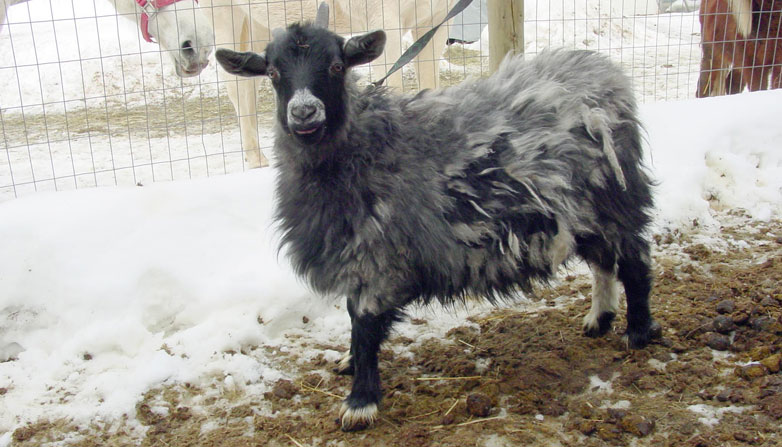About the Fiber
Our goats are registered with the
Pygora Breeder's Association. There is no "good" or "bad" fiber. It all has its own unique qualities. It is a personal preference for the spinner.
Registered Pygora goats will produce cashmere-like fleece (Classified as Type-C), a mohair-like fleece (Type-A), or a combination of the two fleeces (Type-B).
An Introduction to Pygora
The Pygora goat is a cross between an Angora goat that produces mohair, and a Pygmy goat that produces a short, very fine down. The fiber of Pygora goats reflects the best qualities of both the Angora and the Pygmy. From the Angora goat comes long, silky-smooth, lustrous ringlets. The Pygmy goat contributes its' very fine down, in some cases fine enough to be classified as cashmere. This combination of qualities results in fiber with an excellent range of characteristics that maintain fineness as the animal ages. Pygora fiber may be spun and then knitted, woven or crocheted. Because of the fineness of the fiber, it spins into a lovely yarn that is soft enough to be worn next to the skin. Items such as baby garments or luxurious shawls are well suited to Pygora yarn. Pygora also felts beautifully and locks of Pygora may be used to create wigs, beards or novelty toys. Pygora pelts make wonderfully posh rugs or chair accessories. Thus, Pygora fiber is fast becoming crafts persons' and fiber artists' preferred choice for any number of diverse projects. A registered Pygora goat may contain up to 75% of either Angora or Pygmy genes-and as little as 25% of the other breed (as well as any combination between these extremes). Not surprising, therefore, these goats can have a range of fiber types. For this reason, the Pygora Breeders Association developed carefully-defined breed standards for 3 Pygora fiber types (these definitions of the Pygora Fiber types come from the PBA Pygora Breed Standards):
Type A is a long fiber, averaging 6+ inches in length. It drapes in long lustrous ringlets. It may be a single coat, but a silky guard hair is usually present. The fiber is very fine, mohair-like, usually less than 28 microns. The handle should be silky, smooth and cool to the touch.
Type B is a fiber with characteristics of both mohair type and cashmere type fleece. It's usually curly and should average 3 to 6 inches in length. There is an obvious guard hair. A second silky guard hair is also usually present. There should be luster and the handle should be soft and airy. The fiber should test, on average, below 24 microns. The fleece color is usually lighter than the guard hair color.
Type C is a very fine fiber, usually below 18.5 microns, and can be acceptable as commercial cashmere. It must be a least 1 inch long and is usually between 1 to 3 inches. It has a matte finish and a warm, creamy handle. It must show crimp. There is good separation between a coarse guard hair and fleece. The fleece color is usually lighter than the guard hair color.
From Wikipedia, the free encyclopedia

